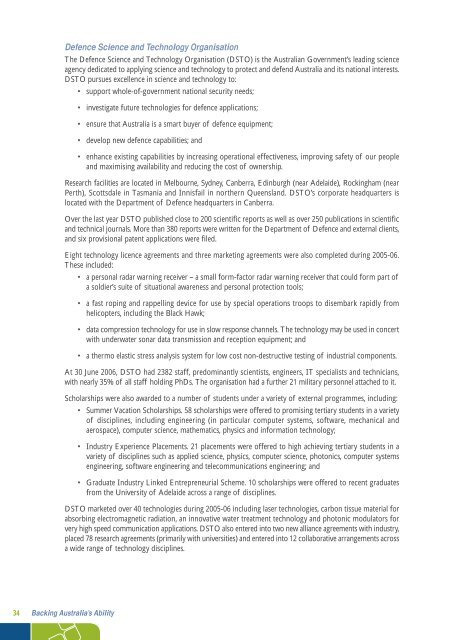The Australian Government's Innovation Report
The Australian Government's Innovation Report
The Australian Government's Innovation Report
You also want an ePaper? Increase the reach of your titles
YUMPU automatically turns print PDFs into web optimized ePapers that Google loves.
Defence Science and Technology Organisation<br />
<strong>The</strong> Defence Science and Technology Organisation (DSTO) is the <strong>Australian</strong> Government’s leading science<br />
agency dedicated to applying science and technology to protect and defend Australia and its national interests.<br />
DSTO pursues excellence in science and technology to:<br />
• support whole-of-government national security needs;<br />
• investigate future technologies for defence applications;<br />
• ensure that Australia is a smart buyer of defence equipment;<br />
• develop new defence capabilities; and<br />
• enhance existing capabilities by increasing operational effectiveness, improving safety of our people<br />
and maximising availability and reducing the cost of ownership.<br />
Research facilities are located in Melbourne, Sydney, Canberra, Edinburgh (near Adelaide), Rockingham (near<br />
Perth), Scottsdale in Tasmania and Innisfail in northern Queensland. DSTO’s corporate headquarters is<br />
located with the Department of Defence headquarters in Canberra.<br />
Over the last year DSTO published close to 200 scientific reports as well as over 250 publications in scientific<br />
and technical journals. More than 380 reports were written for the Department of Defence and external clients,<br />
and six provisional patent applications were filed.<br />
Eight technology licence agreements and three marketing agreements were also completed during 2005-06.<br />
<strong>The</strong>se included:<br />
• a personal radar warning receiver – a small form-factor radar warning receiver that could form part of<br />
a soldier’s suite of situational awareness and personal protection tools;<br />
• a fast roping and rappelling device for use by special operations troops to disembark rapidly from<br />
helicopters, including the Black Hawk;<br />
• data compression technology for use in slow response channels. <strong>The</strong> technology may be used in concert<br />
with underwater sonar data transmission and reception equipment; and<br />
• a thermo elastic stress analysis system for low cost non-destructive testing of industrial components.<br />
At 30 June 2006, DSTO had 2382 staff, predominantly scientists, engineers, IT specialists and technicians,<br />
with nearly 35% of all staff holding PhDs. <strong>The</strong> organisation had a further 21 military personnel attached to it.<br />
Scholarships were also awarded to a number of students under a variety of external programmes, including:<br />
• Summer Vacation Scholarships. 58 scholarships were offered to promising tertiary students in a variety<br />
of disciplines, including engineering (in particular computer systems, software, mechanical and<br />
aerospace), computer science, mathematics, physics and information technology;<br />
• Industry Experience Placements. 21 placements were offered to high achieving tertiary students in a<br />
variety of disciplines such as applied science, physics, computer science, photonics, computer systems<br />
engineering, software engineering and telecommunications engineering; and<br />
• Graduate Industry Linked Entrepreneurial Scheme. 10 scholarships were offered to recent graduates<br />
from the University of Adelaide across a range of disciplines.<br />
DSTO marketed over 40 technologies during 2005-06 including laser technologies, carbon tissue material for<br />
absorbing electromagnetic radiation, an innovative water treatment technology and photonic modulators for<br />
very high speed communication applications. DSTO also entered into two new alliance agreements with industry,<br />
placed 78 research agreements (primarily with universities) and entered into 12 collaborative arrangements across<br />
a wide range of technology disciplines.<br />
34 Backing Australia’s Ability












![[Tam] Uygula[ya] - Bilim, Teknoloji ve Ä°novasyon Politikaları TartıÅma ...](https://img.yumpu.com/36820041/1/184x260/tam-uygulaya-bilim-teknoloji-ve-anovasyon-politikalara-tartaama-.jpg?quality=85)



